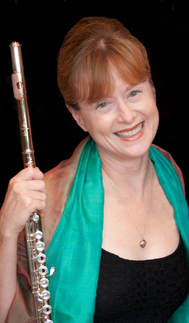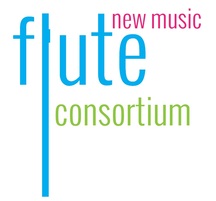Get to Know...Jan Vinci FNMC Artistic Advisor Jan Vinci, has been a staunch supporter of FNMC from the beginning, providing us with invaluable advice, serving as a preliminary round judge, and joining us as a Commissioning Member for both the Zhou Long and the Carter Pann commissions. We’re so happy that she’ll be sharing her wisdom about the commissioning process as a part of the panel for “Keeping Score: A Conversation About Commissioning New Works” during this year’s NFA Convention (2017). Jan has commissioned and/or premiered more than forty works, she is definitely an expert at the process and we're really looking forward to learning from her and the other members of the panel at the convention! Q&A with Jan… What advice can you give to flutists about approaching new music in practice? When learning an older work, one can easily get caught up in, and always follow, performance traditions. However, the beauty of learning a new work is that the journey of discovery is always fresh. … First, I first look at the large structure and the general energy of the rhythms, articulation and dynamics. Then I dig into the multiple layers of details that support the large structure and the general character. I look for contrasts and ways to bring those across, knowing that contrast is what can help define ideas and structure. I also compare the structure of the motives, phrases and sections to music of other eras, as this can often reveal logic of compositional development. Just remember that if we get so caught up in only the details, we lose perspective of the composer's larger picture and, consequently, we lose the overall impact of the work. This mistake leads to a mediocre presentation of a composer's work, which sometimes can discourage other flutists from wanting to perform the work. … Also, I have found that the fresh approach to learning a new work has taught me to take new approaches to interpreting older compositions, often unlocking new and interesting perspectives. What about new music for the flute appeals to you? As in any era, very few pieces end up being considered “exceptional compositions.” Even many pieces by our giants, such as Bach and Beethoven, are not strong enough to earn that label. I have played a lot new music that, no doubt, may never be played again. But as a performer, I feel a responsibility to put new pieces out there because there WILL be new works that deserve longevity and appreciation for years to come. The new pieces that have lasting potential are those that have logic and appeal to the performer and the listener alike: Pieces that have a clear macro and micro structure (Mei for solo flute by Fukushima); Pieces that utilize contemporary techniques for the sake of the music (Idyll for the Misbegotten for flute and percussion by George Crumb); Not always, but… some pieces that are programmatic or have a philosophical inspiration (Medieval Suite for flute and piano by Katherine Hoover and Crow’s Nest for solo flute by Mark Vinci). It is very interesting to read autobiographies of noted performers and conductors who have experienced the birth of new compositions. Their predictions of a new work’s eventual success or demise are most often correct. Do you have any upcoming events that you would like our friends and followers to know about? I would like to tell FNMC members about my latest commission project in which I commissioned 3 works and recorded them on American FluteScape: A Tapestry of Premieres and Classics (Albany Records). I hope FNMC members will check out these very worthy and exciting new works! 1. Along with pianist and Skidmore colleague Pola Baytelman, I commissioned a flute sonata by Jennifer Higdon. Being a flutist, Jennifer has written a lot of flute music, but never a sonata; so, I felt it was time. … Flute Poetic for flute and piano starts with the first movement that Higdon describes as a frantic schizophrenic dialogue with an unpredictable opening - like a picture going in and out of focus. Contrastingly, “Blue Hills” soars with sublime passionate melodies that are bookended with rhythmic introspections. In this movement two, Higdon was thinking of her brother Andrew Blue, who had a sad untimely death, and the beautiful refuge of Cades Cove in East Tennessee where they grew up. From the first note of movement three, “Jagged” creates an energy that is relentlessly on the verge of bursting… and, at the end, it finally does! 2. I commissioned Juilliard Jazz faculty and my husband ☺ Mark Vinci to compose Crow’s Nest for solo flute. As only an avid fisherman and a masterful musician can, Mark sonically depicts the ocean’s dynamic dichotomy of the tumultuous and the serene, as seen from the vantage point of a sailor up in a ship’s crow’s nest. This fantastically fun piece is a springboard for classical flutists to dive into the world of jazz, and begs the performer to ornament, beat box and groove. Inspired by Mark and other world-class jazz musicians, and by the rock-in-roller Ian Anderson (recollecting a Jethro Tull concert that I attended in 1973 in Knoxville, TN), I thoroughly enjoyed adding my own spin on this solo of both virtuosity and tranquility. 3. I also commissioned Mark Vinci to compose a flute concerto TINGsha Bom t-Bom t-Bom for flute and orchestra. Using both classical structures and improvisational style, he creates a wide swath of emotional and rhythmic scenarios. The opening movement, “En garde!,” is a jousting banter between the flutist and the orchestra. Inspired by small Tibetan Tingsha chimes, the second movement, “TINGsha,” lures the listener into ethereal and otherworldly realms with the flutist’s use of unusual flute fingerings, simultaneous singing and playing, bending notes and flutter tonguing. “Bom t-Bom t-Bom” opens with an extended jazz flute cadenza that eventually sets up an infectious rhythmic theme depicting a roving caravan of camels, minstrels, gypsies and vagabonds. Grooving variations ensue first by orchestral winds, followed by jazzy pizzicato strings, and eventually elaborated by the soloist. All end tutti with a rousing rhythmic coda! More About Jan… Classical Recording Foundation Awardee and First Prizewinner of England's International Electric Music Performance Competition, Jan Vinci has performed in Alice Tully, Carnegie, and Merkin Halls and for events such as the Blossom Festival, ICMC in The Netherlands, Electric Music Festival in England and Killington Music Festival. She is often the featured artist for flute club festivals and performs for NFA conventions. Vinci recorded three CD's on Albany Records. Vinci's newest Albany Records CD is American FluteScape: A Tapestry of Premieres and Classics, which includes three works that she commissioned: Mark Vinci's "TINGsha Bom-t-Bom-t-Bom for flute and orchestra” and “Crow’s Nest for solo flute,” and Pulitzer Prize winner Jennifer Higdon’s “Flute Poetic for flute and piano” (co-commissioner Pola Baytelman). As an avid proponent of new works, Vinci’s recent commission projects include Pulitzer Prize winner Long Zhou’s “Confluence for solo flute” (as part of the Flute New Music Consortium) and Carleton Macy's "Autumn Sky: Fantasy for flute and concert band." Vinci earned a D.M.A. from The Juilliard School, M.M. from The Cleveland Institute of Music, and B.M. from Bowling Green State University, studying with Julius Baker, Samuel Baron, Maurice Sharp and Judith Bentley. Former faculty member of Queens College, Hofstra University and the Skidmore Flute Institute, Vinci is Senior Artist-in-Residence at Skidmore College and often teaches master classes at colleges. Vinci served as President of the New York Flute Club. For a breadth of musical offerings by Ms. Vinci, please visit janvinci.com.
0 Comments
Leave a Reply. |
AuthorThe Flute New Music Consortium Archives
March 2018
Categories |

 RSS Feed
RSS Feed
